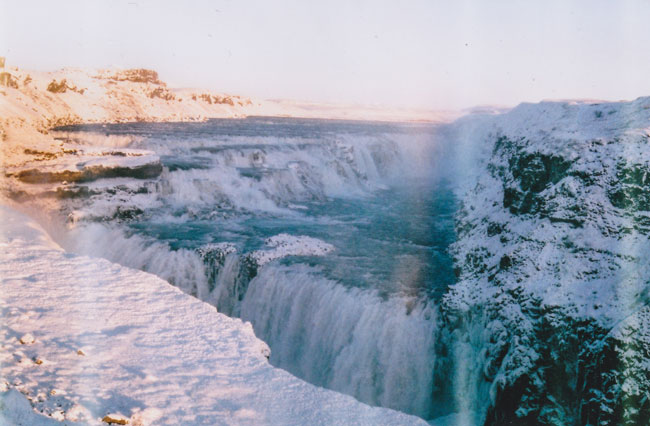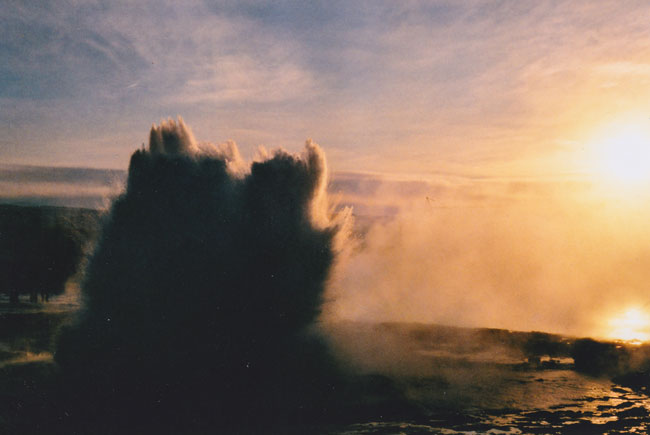At around 8.30am, without fanfare or announcement of any kind, a small black tour bus pulled up outside our Airbnb flat in suburban Rekjavík. Seemingly sunk in knee-high powdery, crystalline snow – freshly fallen from the blizzard the night before – the bus was a glowing beacon in a dark November morning, the sun not rising until 9.15am. Inside, our tour guide from Geo Iceland, a company specialising in small day tours of Iceland’s most notable natural attractions, waited in a traditional Icelandic sweater, all thick wool and delicate patterns, slightly frazzled from use. After a cheery greeting, Steinþór – which he later told us translated to “rock god”, and certainly, with his cropped inky black hair and almost translucently pale skin, he looked like the tamest incarnation of Ozzy Osbourne – promised us a wake up like we’d never imagined, as we rode through the region’s cherished Golden Circle: a waterfall, geysirs, yet another waterfall and a solitary wander through Iceland’s historical and spiritual heart.
I had booked my trip to Iceland the previous summer while planning a trip to Donegal to visit a friend in the midst of holiday ennui. Somewhere along the way, we had just … kept going north. Every travel site we read told us we had to take the Golden Circle tour, an eight-hour, 300 km journey through the country’s rugged lava fields and snow-frosted mountains from Reykjavík to more barren and craggy southlands. As far as I was concerned, the more remote the better. Right before we left, essay season had made itself known, and, I mean, if you have to physically run away from 5,000-word essays, you can do worse than fleeing to the land of fire and ice.
We slowly woke up alongside mountains and between frozen lakes, the sulphurous steam of geothermal power stations clogging the indigo-hued light and gradually giving way to the most leisurely sunrise you can imagine. Iceland has long been a pioneer in the use of geothermal energy, but even they’ve upped their efforts in recent years. Currently 25 per cent of all electricity production is geothermal, while the other 75 per cent is hydropower. This focus on tapping into the country’s natural resources is followed through in its supply of water: hot water is pulled from the famous hot springs and, for this reason tastes strongly of sulphur, a strange mix of rotten egg and something sweet hovering in the aftertaste, maybe marshmallow. Showers are a terrifying experience because of it: your predominant thought is that you’re going to die choking in a cloud of rotten egg-flavoured steam, but you adjust. As if to prove that Iceland is a country of extremes, the contra to the hot hell water is cold water that is actual glacial runoff and is the purest water you’ll ever drink.
As if to prove that Iceland is a country of extremes, the contra to the hot hell water is cold water that is actual glacial runoff and is the purest water you’ll ever drink.
The first stop on our trip is to the town of Hveragerði, named for the hot spring (“hver”) it’s built on. Between its spartan wooden houses, painted saturated shades of blue and red that contrast sharply with the pristine snow, are bubbling wells of hot water and steam, like pockmarks in the earth. Curiously located in a shopping centre is an exhibition on the 2008 6.3 magnitude earthquake that rocked the town, the most fascinating aspect of which is an earthquake crack unearthed during the construction of the shopping centre. Placed under a glass floor, one side marked North America and the other Europe, it’s a perfect photo opportunity should you find yourself there with an American friend and a Russian one. It was here that Steinþór decided to drop his bombshell of a secret on us: he daylights (nightlights? Twilight-lights?) as a landscape gardener. He tells us that Hveragerði is one of the agricultural centres of Iceland, growing tomatoes in their thousands in amber-coloured greenhouse that, in the middle of a white and blue Icelandic winter, radiate an enviable golden warmth.
Perhaps thanks to the company’s focus on small groups, and the slower pace in general in Iceland, Steinþór was insistent on letting his passengers have a few stolen moments to savour the scenery. On our retreat from Hveragerði, through a glaciated valley soft with snow, he gently pulls to the side of the road, encouraging our 12-person strong troupe to put ourselves in the way of beauty. “The light here, it iss very spessial”, he murmurs in his peculiarly soothing Icelandic lilt, pointing east to a sunrise unfolding before our eyes, and suddenly Beckett essays and personal troubles seem millennia away.
Next, we’re bundled away to Faxi, a small waterfall embedded in the Tungufljót river and comically close to a main road. The river is particularly rich in salmon, one of Iceland’s most desired products, though on this day it resembles an artist’s study in the colour white. Tendrils of grass fight their way through the snow blanket, the gushing walls of frothy water create more of a mumble than a roar, and the water’s edge is dotted with the frozen skeletons of flowers, their colour long gone but blooms preserved in ice. Faxi is like a gateway waterfall, a brief taster of nature’s raw and awesome beauty before the main attraction: Gullfoss.

In literature, there’s a concept called “the sublime”, popularised by Edmund Burke, which describes anything so beautiful as to excite pain, pleasure and terror in the viewer. Certainly, Gullfoss ticks those boxes. Monumental in size and flowing over two levels into a 32-metre-deep crevice, the falls are observable from a wooden viewing deck that leaves you completely at the mercy of the wind and water spray. The falls has also become something of a symbol of Iceland’s resilience and commitment to preserving its natural beauty. In the early 20th century, it was under threat of being used to generate electricity, before being sold to the government and protected. Sigríður Tómasdóttir, the daughter of Tómas Tómasson, one of the owners of the falls, is presented as the saviour of the natural marvel, even threatening to drown herself into it, though the story is questioned. Regardless, watching the long sunset begin over Gullfoss, stretching shadows into brushstrokes, it’s not inconceivable that one would risk one’s life for it.
The beauty of Gullfoss is certainly best observed from afar, though the same can’t be said of the geysirs in Iceland’s geothermal centre. The sensation of feeling the earth shake as a pillar of water and steam erupts from an ancient crater is unlike anything else, as is the experience of walking through the subsequent clouds of sulphur. Strokkur is the main spring, erupting every 10 minutes and always taking its audience by surprise. But coming upon Geysir, the now-dormant hot spring that gave the phenomenon its name, is like finally greeting an elderly granduncle whose tales of mischief and adventure are legendary, but who is now serene. Silent.
Coming upon Geysir, the now-dormant hot spring that gave the phenomenon its name, is like finally greeting an elderly granduncle whose tales of mischief and adventure are legendary, but who is now serene. Silent.
With the sun getting ever lower, we make our way to Þingvellir (pronounced “Thingvellir”) as Steinþór gives us a crash course in Icelandic music while we consume spoonfuls of skyr, a lusciously thick Icelandic dairy product and national treasure. Deflecting my mental pleas for the atmospheric intonations of Sigur Rós, he plucks for Björk, regaling us with his knowledge of the varied gems of the Icelandic music scene. Somehow her high pitched, almost alien vocals suited the extraterrestrial terrain of Iceland’s national park: all frozen streams of silver, looming walls of mountain and the dying golden tendrils of sunset.
The park was the site of the national parliament, the Althing, founded in 930 and held there until 1798. Now, the enormous expanse of flat land and trees is a World Heritage Site and a tourist attraction, particularly known for its Silfra Lake, where a crevice has developed due to continental drift. Sounds are muffled by the mounds of snow around you, and crossing its wooden bridges and climbing its curved timber stairs feels like passing into an entirely different time. Maybe it’s the gradual shifting of light, or maybe it’s the solidity of its natural wonders but in Þingvellir time seems to slow to a creep. Voices seem close and hushed and the rock pathway leading to the viewing point is dotted with caverns and caves long since cordoned off. At its peak, a panorama of the park awaits you, an awe-inspiring 360° of untamed nature.
On the way back to Reykjavík, Steinþór tells us fairy tales and is unsurprisingly amazing at it. He tells us of the Christmas legend of the 13 Icelandic Yule Lads and their ogress mother, Grýla, who all live in the mountains with a black cat. His soft Icelandic “s” sounds make it impossible to resist sleep as the short day comes to a close. The achievement of Iceland is certainly its focus on maintaining this aspect of magic and majesty amidst a tourism boom that’s seen the government enforce restrictions on Airbnb properties. Though its many hours of darkness and cold seem like qualities antithetical to a getaway location in the middle of essay panic and whatever personal worries one might have, they succeed also in making the most of whatever light they have. There’s an Icelandic phrase that sums this up succinctly: “raðljóst”, which roughly translates as “enough light to navigate by”. So if you need to scramble around in the dark for a while, do it in Iceland.







